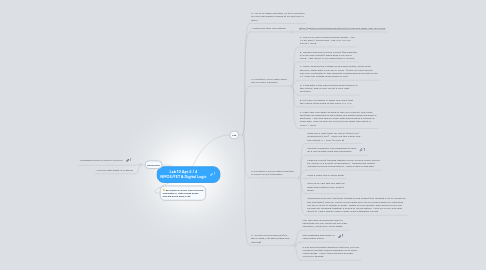
1. Resources
1.1. Wikipedia article on NMOS 2N7000
1.2. 2N7000 data sheet is in github
2. BE GENTLE WITH THE 2N7000 Transistors! They break easily and we don't have a lot.
3. Lab
3.1. 0. For all of these activities, I'd try to do them on your own before looking at my pictures or hints!
3.2. 1. Download stuff from github
3.2.1. https://github.com/stevekochscience/2012-Physics-308L-Lab-10-NMOS
3.3. 2. Construct a NOT gate using one 2N7000 transistor
3.3.1. A. Use a 270 ohm current limiting resistor. Use +5 for drain / source bias. Use 0 or +5V for FALSE / TRUE.
3.3.2. B. Measure the drain source current (through the 270-ish ohm resistor) when gate is FALSE or TRUE. I get about 17 mA when there is current.
3.3.3. C. Next, Measure the voltage AFTER the resistor, at the drain terminal, when gate is FALSE or TRUE. (Note: you will need to use your multimeter in two different configurations for parts B and C). Does the voltage make sense to you?
3.3.4. D. If the gate is the input and the drain terminal is the output, how is your circuit a NOT logic function?
3.3.5. E. Put two NOT gates in series and verify that the output is the same as the input T=T, F=F
3.3.6. F. Insert two LED lights at each of the NOT outputs, and verify that they are opposite of each other and switch when the input is switched. I still find this fun even after having done it almost 20 years ago! Wire up the LED so it turns on when the output is HIGH = TRUE
3.4. 3. Construct a NAND gate using two 2N7000 NMOS transistors
3.4.1. Write out a logic table for NAND (look it up / understand it, etc.). There are two inputs and one output: F = NOT (A AND B)
3.4.2. Use this schematic from wikipedia to wire up a NAND gate using two transistors.
3.4.3. Measure current through Resistor-Drain-Source-Drain-Source for various A & B input combinations. Measure the output voltage for those combinations. Make a table of the data.
3.4.4. Does it seem like a NAND gate?
3.4.5. Wire up an LED that will light up when the output is true. Does it work?
3.4.6. Assuming you're just using the voltage of the output (not drawing a lot of current to the next gate), does an NMOS NAND gate use a lot of current when it's outputing FALSE or TRUE or neither or both? Based on your answer, why would NMOS not be ideal for stringing together a bunch of NAND gates? Look up CMOS and read about it! That's what's used in large-scale integrated circuits.
3.5. 4. Do this if you're bad-ass (no extra credit, just extra praise and learning)
3.5.1. Use LabVIEW and boolean logic to show that you can construct any logic operation, using only NAND gates.
3.5.2. See Wikipedia discussion in Logic gates article
3.5.3. If you have enough transistors and time, you can construct another logical operation from some NAND gates. I don't think we have enough 2N7000's though.
